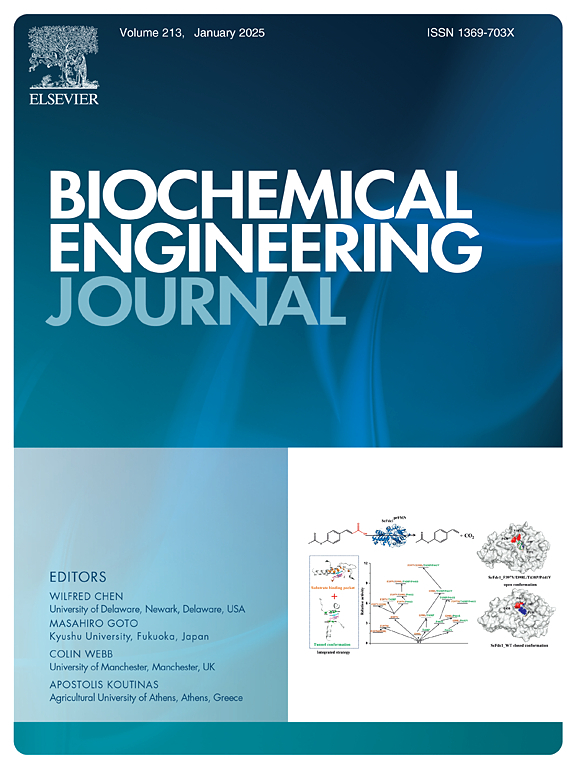Corn stover waste preparation cerium-modified biochar for phosphate removal from pig farm wastewater: Adsorption performance and mechanism
IF 3.7
3区 生物学
Q2 BIOTECHNOLOGY & APPLIED MICROBIOLOGY
引用次数: 0
Abstract
The high phosphorus content in livestock and poultry wastewater is a significant factor contributing to water eutrophication. It is imperative to seek an economically efficient method for phosphate recovery. This study employed cerium-modified biochar to recover phosphate from pig farm wastewater. An investigation was conducted to examine the adsorption performance and removal mechanism of phosphate. Among the different samples, 0.1CeB-500℃ was selected for subsequent experiments. It exhibited a phosphate adsorption capacity of 9.58 mg/g and a removal efficiency of 95.75 %. The results showed that the phosphate adsorption process followed not only the pseudo-second-order kinetic model, but also the Langmuir isotherm model. It suggested that the adsorption of phosphate onto the biochar occurred in a monolayer chemical manner, with a maximum adsorption capacity of 10.86 mg/g. Phosphate adsorption was minimally affected within the pH range of 2–9, with Cl- having negligible impact, NO3- slightly inhibiting, and HCO3- and CO32- significantly hindering phosphate adsorption. A series of characterization results indicated that phosphate removal occurred through surface precipitation forming CePO4, ligand exchange between carbonate and phosphate, inner-sphere complexation, and electrostatic attraction. The phosphate removal efficiency from pig farm wastewater was 43.25 %, demonstrating promising potential for practical application.
玉米秸秆废料制备的铈改性生物炭用于去除养猪场废水中的磷酸盐:吸附性能和机理
畜禽废水中的高磷含量是导致水体富营养化的一个重要因素。当务之急是寻求一种经济高效的磷酸盐回收方法。本研究采用铈改性生物炭从养猪场废水中回收磷酸盐。对磷酸盐的吸附性能和去除机理进行了研究。在不同的样品中,选择了 0.1CeB-500℃ 进行后续实验。其磷酸盐吸附容量为 9.58 mg/g,去除率为 95.75 %。结果表明,磷酸盐的吸附过程不仅遵循伪二阶动力学模型,而且遵循 Langmuir 等温线模型。结果表明,生物炭对磷酸盐的吸附是以单层化学方式进行的,最大吸附容量为 10.86 mg/g。在 pH 值为 2-9 的范围内,磷酸盐的吸附受到的影响很小,Cl- 的影响可以忽略不计,NO3- 有轻微的抑制作用,而 HCO3- 和 CO32- 则明显阻碍磷酸盐的吸附。一系列表征结果表明,磷酸盐的去除是通过表面沉淀形成 CePO4、碳酸盐与磷酸盐之间的配体交换、内球络合和静电引力实现的。养猪场废水中的磷酸盐去除率为 43.25%,显示出了很好的实际应用潜力。
本文章由计算机程序翻译,如有差异,请以英文原文为准。
求助全文
约1分钟内获得全文
求助全文
来源期刊

Biochemical Engineering Journal
工程技术-工程:化工
CiteScore
7.10
自引率
5.10%
发文量
380
审稿时长
34 days
期刊介绍:
The Biochemical Engineering Journal aims to promote progress in the crucial chemical engineering aspects of the development of biological processes associated with everything from raw materials preparation to product recovery relevant to industries as diverse as medical/healthcare, industrial biotechnology, and environmental biotechnology.
The Journal welcomes full length original research papers, short communications, and review papers* in the following research fields:
Biocatalysis (enzyme or microbial) and biotransformations, including immobilized biocatalyst preparation and kinetics
Biosensors and Biodevices including biofabrication and novel fuel cell development
Bioseparations including scale-up and protein refolding/renaturation
Environmental Bioengineering including bioconversion, bioremediation, and microbial fuel cells
Bioreactor Systems including characterization, optimization and scale-up
Bioresources and Biorefinery Engineering including biomass conversion, biofuels, bioenergy, and optimization
Industrial Biotechnology including specialty chemicals, platform chemicals and neutraceuticals
Biomaterials and Tissue Engineering including bioartificial organs, cell encapsulation, and controlled release
Cell Culture Engineering (plant, animal or insect cells) including viral vectors, monoclonal antibodies, recombinant proteins, vaccines, and secondary metabolites
Cell Therapies and Stem Cells including pluripotent, mesenchymal and hematopoietic stem cells; immunotherapies; tissue-specific differentiation; and cryopreservation
Metabolic Engineering, Systems and Synthetic Biology including OMICS, bioinformatics, in silico biology, and metabolic flux analysis
Protein Engineering including enzyme engineering and directed evolution.
 求助内容:
求助内容: 应助结果提醒方式:
应助结果提醒方式:


